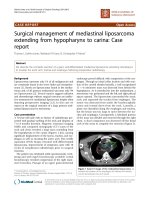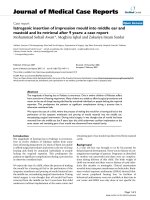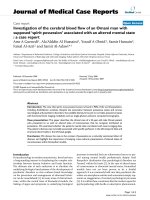Surgical management of dystocia due to monocephalus thoracopagus tetrabrachius tetrapus dicaudatus monster foetus by caesarean section - A case report
Bạn đang xem bản rút gọn của tài liệu. Xem và tải ngay bản đầy đủ của tài liệu tại đây (166.73 KB, 4 trang )
Int.J.Curr.Microbiol.App.Sci (2020) 9(7): 2873-2876
International Journal of Current Microbiology and Applied Sciences
ISSN: 2319-7706 Volume 9 Number 7 (2020)
Journal homepage:
Case Study
/>
Surgical Management of Dystocia due to Monocephalus Thoracopagus
Tetrabrachius Tetrapus Dicaudatus Monster Foetus by
Caesarean Section- A Case Report
B. M. Nijin Jos*
Veterinary Surgeon, Veterinary Dispensary, Cumbummettu
Kerala Animal Husbandry Department, India
*Corresponding author
ABSTRACT
Keywords
Calf, Dystocia,
Fetal monster,
Thoracopagus,
Tetrabrachius,
Tetrapus, Caesarean
section
Article Info
Accepted:
22 June 2020
Available Online:
10 July 2020
A conjoined monster calf was delivered by caesarean section in a crossbred
Holstein Friesian heifer. The calf was partially duplicated with single head
(Monocephalic), two male foetuses joined at the thoracic region
(Thoracopagus) and having well developed eight limbs that is four fore
limbs (Tetrabrachius) and four hind limbs (Tetrapus) and both pelvis were
separate (Dicaudatus). The occurrence of foetal monstrosities often leads to
difficulty in parturition and also failed to be delivered by mutational
operations. The present report records a successful management of dystocia
due to monocephalic thoracopagus tetrabrachius tetrapus monster calf in a
crossbred Holstein Friesian by caesarean section.
Introduction
Dystocia or difficulty in parturition can be
due to maternal or fetal origin. Bovine
practitioners are often presented with such
condition where scientific manipulation is
required to correct the presentation to bring
about a normal delivery. Caesarean section is
considered when the fetus cannot be delivered
by fetal mutation and extraction (Schultz et
al., 2008). Absolute fetal oversize,
malposition, fetal anasarca, schistosoma
reflexus, hydrocephalus, conjoined twins,
emphysematous,
mummification,
and
prolonged gestation (Campbell and Fubini,
1990) etc. are the conditions that are of fetal
origin that can lead cesarean section.
Monsters are abnormal fetuses that usually
have altered appearance (Purohit, 2006),
results from developmental disturbances that
involves various organs and systems (Vegad,
2007). They are usually associated with either
with infectious diseases or congenital defects
(Arthur et al., 2001) and may or may not
interfere with birth (Sharma et al., 2010;
2873
Int.J.Curr.Microbiol.App.Sci (2020) 9(7): 2873-2876
Gupta et al., 2011). Abnormal duplication of
germinal area in fetus will give rise to
congenital fetal abnormalities with partial
duplication of body structure (Roberts, 2004).
Dystocia is a common sequel of monstrosity,
so it is important to know various types of
monsters which cannot be removed without
Caesarean section or fetotomy most of the
time (Gupta et al., 2011).
This communication reports a rare case of
conjoined monster calf (Monocephalus
Thoracopagus
Tetrabrachius
Tetrapus
Dicaudatus) in a cross bred Holstein Friesian
heifer which was relieved by caesarean
section.
Case history and clinical observations
A three year old crossbred Holstein Friesian
heifer was presented to veterinary dispensary
cumbummettu in sternal recumbency with
history of full term gestation and shows
severe straining since last 8 hours, water bag
ruptured few hours before but the animal is
not able to deliver the calf. Detailed Gynaecoclinical examination revealed that the birth
canal was completely impacted with four
limbs and head. Per vaginal examination
revealed no demarcation of thorax and four
limbs could be palpated at untoward places.
The condition was tentatively diagnosed as
fetal monster.
Treatment
The surgical procedure was done under
Xylazine hydrochloride sedation at the rate of
0.1mg
per
Kilogram
bodyweight
intramuscularly and regional anaesthesia was
accomplished by inverted L block using 2%
Lignocaine. The animal was placed in right
lateral recumbency and the surgical site was
clipped shaved and prepared for aseptic
surgery. An oblique incision was made in the
left lower flank downward and forward. The
incision was deepened by incising through the
muscle layers and peritoneum to reach the
abdominal cavity. The uterus was exteriorized
and a knick incision was made in the uterus
which was extended with scissors. The foetus
was tracted out gently after careful
manipulation. The uterine incision was closed
with catgut (Size 1) in double layer inversion
suture pattern, thereafter muscles and skin
was apposed in routine manner. Polyglycolic
acid 1 suture was used for apposing muscle
layers and Nylon for skin. Post operatively
the dam was maintained on fluids, antibiotics
and other supportive therapy. The animal was
reported to have recovered uneventfully.
Results and Discussion
A cross bred Holstein Friesian heifer
presented with dystocia was diagnosed with
foetal monster on per vaginal examination.
Caesarean section was performed to remove
the foetus from the dam. The calf when
removed after caesarean section was found to
be monocephalus tetrabrachius tetrapus
dicaudatus
monster.
The
dam
was
administered fluids, antibiotics and other
supportive therapy post operatively. The
animal reported to have recovered
uneventfully.
Fetal monstrosity develops when a
disturbance occurs in the development of
various organs and systems which can cause a
great distortion in the individual (Vegad,
2007). The incidence of fetal monstrosities is
rare but when it occurs it often leads to
caesarean section or fetotomy (Sharma et al.,
2013). Dystocia that occur due to fetal
monsters are relieved by caesarean section
more than fetotomy as it is of limited
usefulness except in a few cases of monsters
(Dholpuria et al., 2016). Caesarean section
can be done in the left oblique ventro-lateral
site, as this site causes minimum post
operative contaminations and lesser postoperative complications (Verma et al., 1974
and Singh et al., 1978).
2874
Int.J.Curr.Microbiol.App.Sci (2020) 9(7): 2873-2876
Fig.1 Monocephalus thoracophagus tetrabrachius teterapus dicaudatus monster calf delivered
through caesarean section
Acknowledgement
The author would like to acknowledge
Director,
Kerala
Animal
husbandry
Department and District Animal Husbandry
Office, Idukki for providing the facilities for
the successful completion of the work.
References
Arthur, G. H., Noakes, D. E., Pearson, H.,
Parkinson, T. J. 2001. Veterinary
Reproduction and Obstetrics. Edn 8,
Vol. I, W.B. Saunders Co. Ltd. London,
England. 544-545.
Campbell, M.E. and Fubini, S.L. 1990.
Indications and surgical approaches for
cesarean section in cattle. Compend
Contin. Educ. Pract. Vet. 12: 285–292.
Dholpuria, S., Saraswat, C. S., Thanvi, P. and
Sharma, S. 2016. Per-vaginal successful
management of a rare case of dystocia
in murrah buffalo due to dicephalus
thoracophagus tetrabrachius tetrapus
and dicaudatus monster: A case report.
Theriogenology. 6(1): 35-40.
Gupta, V. K., Sharma, P., Shukla, S. N. 2011.
Dicephalus monster in a Murrah
buffalo. Indian Vet. J. 88(12): 72-73.
Purohit, G. N. 2006. Dystocia in sheep and
goat - A review. J. Small Ruminants.
12(1):1-12.
Roberts, S.J. 2004. Veterinary Obstetrics and
Genital Diseases. CBS Publishers, New
Delhi. India.
Schultz, L.G., Tyler, J.W., Moll, H. D., and
Constantinescu, G.M. 2008. Surgical
approaches for cesarean section in
cattle. Can. Vet. J. 49(6): 565–568.
Sharma, A., Kumar, P., Singh, M., Vasishta,
N. K., and Jaswal, R. 2013. Rare fetal
monster in Holstein crossbred cow.
Open Vet. J. 3(1): 8–10.
Sharma A, Sharma S, Vasishta VK. A
diprosopus buffalo neonate: A case
report. 2010. Buffalo Bulletin. 29(1):6264.
Singh, J.; Prasad, B. and Rathor, S.S. 1978.
Torsio uteri in buffaloes (Bubalus
bubalis)- An analysis of 65 cases.
Indian Vet. J. 55:161-165.
Vegad, J.L. 2007. 2nd edition. International
book distribution Company; 2007.
Textbook of Veterinary general
pathology.
Verma, S.K.; Manohar, M. and Tyagi, R.P.S.
1974. Cesarean section in bovines: A
clinical study. Indian Vet. J. 51:471479.
2875
Int.J.Curr.Microbiol.App.Sci (2020) 9(7): 2873-2876
How to cite this article:
Nijin Jos, B. M. 2020. Techniques for Determination of Vitamin B6, Vitamin C and Variability
in Areca Nut (Areca catechu) Samples of Karnataka, India. Int.J.Curr.Microbiol.App.Sci.
9(07): 2873-2876. doi: />
2876









